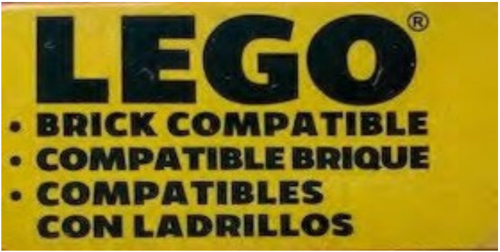21/07/2023·4 mins to read
LEGO v ZURU - A brick by brick analysis of the High Court decision

Key takeaways
- Any use of a rival trader’s registered trade mark carries significant legal risk
-
While comparative advertising is legal, its boundaries are very narrow
-
Seek and follow competent legal advice before taking the risk – poor advice is no defence
Why were they throwing their toys?
The dispute arose after well-known toy manufacturer ZURU launched a plastic brick building product using packaging stating that it was “LEGO® BRICK COMPATIBLE”, in the following form:

LEGO objected to this use of its trade mark, leading ZURU to take the unusual step of asking the High Court to rule that it was not infringing the registered LEGO mark, and seeking declarations that the following three proposed compatibility statements would also not infringe:

Things escalated, with LEGO responding by bringing its own claims against ZURU for registered trade mark infringement, passing off and breach of the Fair Trading Act (FTA). LEGO unsuccessfully sought to strike out ZURU’s claims in a decision issued by the court in 2022, and the matter then proceeded to trial.
Neither side backed down and last week Justice Graham Lang issued a 71 page judgment which ruled resoundingly in LEGO’s favour on the trade mark infringement issue. The judgment makes important findings about the limits on use of another party’s registered trade mark, including in “comparative advertising”.
Court finds ZURU infringed the LEGO trade mark
Use by one business of another’s registered trade mark on the goods for which that mark is registered will amount to infringement under the Trade Marks Act (Act), unless one of the narrow exceptions applies. In this case there was no dispute that the trade mark LEGO was indeed used on ZURU’s toy brick packaging.
However, ZURU sought to rely on several of the statutory exceptions, arguing that:
-
Its use of the word LEGO would not be likely to be seen by consumers as use as a trade mark.
-
Even if this were not the case, there was no trade mark infringement because:
-
The LEGO mark was used in “comparative advertising” protected under s 94 of the Act; and/or
-
ZURU was using the LEGO trade mark to indicate a characteristic of the ZURU product and/or because the use of LEGO was necessary to indicate the intended purpose of that product (permitted under s 95).
-
The Court disagreed. Justice Lang considered that it would be inappropriate to issue declaratory relief in relation to ZURU’s three proposed compatibility statements. In relation to ZURU’s original compatibility statement, Justice Lang held that this infringed the LEGO trade mark for the following reasons:
-
LEGO was clearly used as a trade mark - the word has no meaning of its own. Taking into account factors such as the relative size of the word LEGO and the prominence and stylisation of the “compatibility statement” on the packaging, a substantial number of people would take ZURU to be using LEGO as a trade mark.
-
In order to rely on the defences in ss 94 and 95, ZURU had to have used the LEGO mark in accordance with “honest practices in commercial matters”. It had not. Relevant factors included that:
-
ZURU intended to gain market share by selling products similar to LEGO’s at a cheaper price;
-
the Judge was concerned that ZURU’s actions in NZ were intended to bolster its legal action against LEGO in the US; and
-
ZURU did not advise or obtain consent from LEGO before using its mark - it took a calculated risk. In short, Justice Lang found that ZURU quite deliberately sought to use the LEGO mark to leverage off LEGO’s reputation.
-
-
As part of its claim to have acted in accordance with honest commercial practices, ZURU’s director gave evidence that it had obtained advice from its internal lawyers before using LEGO in the compatibility statements. However, when directed to produce the advice, the director could not recall seeing the advice (which amounted to a one-page internal memo and did little to explain, let alone justify, the position). Justice Lang was clearly unimpressed and scathingly described the advice as “manifestly inadequate given the importance of the issue”.
-
“Comparative advertising” occurs when an advertisement contrasts one brand with another. In this case there was no comparison - simply a statement that the ZURU product was compatible with LEGO’s. Even if there had a been a comparison, ZURU would not have been entitled to rely on the comparative advertising defence because Justice Lang found that it took unfair advantage of the LEGO mark by using it so prominently on the packaging.
-
As to the s 95 defences, which argued that the use of LEGO was to legitimately describe the ZURU product:
-
ZURU’s use of LEGO did alert customers to a characteristic of the ZURU bricks, namely, that they were compatible with LEGO bricks. However, ZURU could not rely on this defence because its use was quite clearly not in accordance with honest practices.
-
It was not reasonably necessary for ZURU to use the LEGO mark to indicate the purpose of its products. That purpose was evident from the container and packaging used for the ZURU products.
-
No liability under the FTA and passing off
In contrast to the success under the Act, LEGO’s claims under the FTA and passing off failed.
Key to both outcomes was that the manner in which ZURU used the LEGO mark was unlikely to confuse or deceive customers into believing that the ZURU product was associated with LEGO. However, given the findings on trade mark infringement, ZURU’s victories on the other claims were hollow.
What does this mean for you?
The result in this case is unsurprising. ZURU was clearly using the LEGO trade mark and did so in a manner that gave real prominence to the use. It would have been difficult to suggest that the manner of the use was intended for any other purpose than to take advantage of LEGO’s reputation.
The judgment clearly highlights the risk of using a rival trader’s registered mark in advertising and marketing. While comparative advertising is allowed under the Act, its boundaries are narrow. Even where the trade mark is used to contrast or compare, a failure to act in accordance with honest commercial practices will mean that the defence will fail.
The judgment also reinforces the critical importance of sound legal advice before using another party’s mark. Unless the advice is sufficiently reasoned and thorough, the mere fact that a party consulted a lawyer will not assist it to defend infringement claims. And a court will be reluctant to make declarations of non-infringement in relation to any proposed forms of use of a trade mark.
Get in touch
If you have any questions about your current advertising, or would like advice from us on any potential action against third parties using your registered intellectual property, please contact us. We will be happy to assist.









